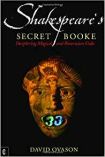Shakespeare's Secret Booke: Deciphering Magical and Rosicrucian Codes by David Ovason
| Shakespeare's Secret Booke: Deciphering Magical and Rosicrucian Codes by David Ovason | |
|
| |
| Category: Spirituality and Religion | |
| Reviewer: John Lloyd | |
| Summary: I believe 33s to be there - and you will too, after this book, but I can't believe they are that important on the evidence here, which is unconvincing, especially for the average layman. | |
| Buy? Maybe | Borrow? Maybe |
| Pages: 256 | Date: November 2010 |
| Publisher: Clairview Books | |
| ISBN: 978-1905570263 | |
|
| |
One group of people that were convinced the Chilean miners, Los 33, would be relieved of their ordeal, were numerologists. For hundreds of years, it seems, they have held the number thirty-three in good stead. It represents a lot of expression of the ego, or the soul, or the transformation of the spirit from one world to another. It doesn't boil down to just the 33 years Christ was supposed to have held His human incarnation, but refers to many ethereal, magical, alchemical transformations from state to state. And who can deny the Chilean mine was 2010's most vivid embodiment of hell - and that the 33 were reborn in coming back to life on earth?
Yes, while many people have been seeing 23s everywhere, others have been seeing 33s. They form a lot of Rosicrucian thinking in coded symbol, and are everywhere we look - including, if this testimony is to be believed, throughout Shakespeare's works, lives - and resulting mysteries. So when Hamlet first meets the ghost of his father, the ethereal world's link to ours is shown in 33-letter lines, and 33-word speeches. The first - and 33rd - lines of "To be, or not to be..." are both 33 letters long. There are echoes in The Tempest - and even in The Comedy of Errors, in what is commonly taken to be an error itself.
But Shakespeare is not alone in this - many other people of the time left small typos or printing quirks on the page, which might have signalled to the initiated that there was a 33 to be found. This only serves as confirmation the signal is being transmitted - it doesn't seem to have meant much more than this. Of course, when looking at the works of Dr John Dee, as this book does, there are very few people who can call themselves initiated. It's complex, and then some - but there are some overt 33s. The habit went as far as Michel de Nostradame, whose cryptic messages contained code inside puzzle inside wordplay - but they also had some 33s included.
The wealth of visual and literary clues here are almost convincing, but as a sceptic (and a layman where much of this is concerned) I remained in a purgatory of my own, seeking more firm proof. One problem is the style of this book, being not exactly friendly to the general reader (and not ideal for the student, being devoid of index). You seek in vain for more than a paragraph defining Rosicrucian ethos. You are expected to have some knowledge of esoterica, and to know what hermeneutics are.
Another problem is that this book suffers in editing. Where it would have interested me the most, with discussion of Shakespeare, Ovason goes pell-mell from one subject to another. After dispensing with (some of the) evidence of 33s in the plays, he features on the church in Stratford with the cursed flagstone, allegedly atop the playwrights' remains, and the memorial on the wall, and their resultant symbolism. But he skips from proof of this to a theory of that to an opinion of the other, and never nails anything down precisely. There have been three flagstones in the church floor, but he never hits on them all in chronological order, and we're forced to work too hard.
What's more, he tries to decode the inscription - or at least an earlier version of it. This involves using a code system much used by Francis Bacon, but there's a vital jump left out of the workings, where we go from a readable mixture of scrunched-up words, with random capital letters, to something else entirely, with no explanation. There's no A-B here. You shouldn't need wikipedia to help you through such a crucial matter (it seems obvious now but eluded me for hours) - especially when the truth about Shakespeare's authorship is one of my favourite Fortean theories. Bacon used 33s as well - and the numerical value of his name? Guess what - 33.
The sceptic will see copious other problems with the theories of 33s, and with this book. Sometimes you must count abbreviations, Latin, initials, years, etc, in your word-count, sometimes not. Sometimes M has a numerical value of 13, sometimes 12 - making it the 12th letter of the alphabet relies on the historical use of I and J as the same, and the footnote reminding us of this comes a hundred pages too late. Late on, the author is delirious in describing two different triangle sets in an artwork as being different, when they are clearly identical in one of the many fine images that pepper the discussion. I could also mention the footnote where bees apparently hurt us by biting, but I don't want to sound too negative.
I did note, however, than Ovason admits to these examples "invit[ing] the imaginative involvement of the reader" - in other, oft-used, words, you only see 33s if you want to see them. Elsewhere, even, the fact a document codes for either 32 or 34 is proof, apparently, that a 33 was being signified. The number "has been revealed as an indicator of the spiritual world, of spiritual verities, as a sign of the entrance to a higher world, and so forth". And this was definitely news to me. But unless you need to know every facet of Rosicrucian thinking, of the way they signalled they were giving out, say, one of their secrets about the Ascent of Man, this will remain one of the most trivial facts you could read an entire book about.
It is not a particularly poor book - it has generally been crafted very well, with a brilliant spread of images, helpful notes and more. The erudition and vocabulary of the author is supreme, and he knows his esoterica. It's a great loss then that this book does not present that in a populist manner. It will remain on the reference shelves of the Fortean Times, but should be reaching a wider audience - instead I feel the attempt at that, pinning everything on the name of Shakespeare in the title, was a bit of a red herring. For the specialist this remains an intriguing book, with the author refuting many theories held elsewhere in favour of his own strongly-given opinions. It is only the specialist, however, to whom I can recommend this title.
I must thank the kind people at Clairview books for my review copy.
If you're interested in the Shakespearean world we can recommend The Boy Who Would Be Shakespeare by Doug Stewart, Shakespeare on Toast by Ben Crystal and The Shakespeare Handbook by Michael Schmidt and Robert Maslen.
Please share on: ![]() Facebook,
Facebook, ![]() Twitter and
Twitter and
![]() Instagram
Instagram
![]() You can read more book reviews or buy Shakespeare's Secret Booke: Deciphering Magical and Rosicrucian Codes by David Ovason at Amazon.co.uk Amazon currently charges £2.99 for standard delivery for orders under £20, over which delivery is free.
You can read more book reviews or buy Shakespeare's Secret Booke: Deciphering Magical and Rosicrucian Codes by David Ovason at Amazon.co.uk Amazon currently charges £2.99 for standard delivery for orders under £20, over which delivery is free.
![]() You can read more book reviews or buy Shakespeare's Secret Booke: Deciphering Magical and Rosicrucian Codes by David Ovason at Amazon.com.
You can read more book reviews or buy Shakespeare's Secret Booke: Deciphering Magical and Rosicrucian Codes by David Ovason at Amazon.com.
Comments
Like to comment on this review?
Just send us an email and we'll put the best up on the site.


